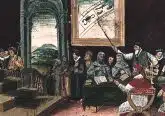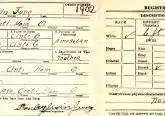Making Sense of the U.S. Census

“In those days a decree went out from Caesar Augustus that all the world should be enrolled. This was the first enrollment, when Quirin’ius was governor of Syria. And all went to be enrolled, each to his own city. And Joseph also went up from Galilee, from the city of Nazareth, to Judea, to the city of David, which is called Bethlehem, because he was of the house and lineage of David, to be enrolled with Mary his betrothed, who was with child. And while they were there, the time came for her to be delivered. And she gave birth to her first-born son and wrapped him in swaddling cloths, and laid him in a manger, because there was no place for them in the inn.” -Luke 2:1-7 (Revised Standard Version).
In the U.S., the Bureau of the Census’ mission is to measure and disseminate information about the nation’s dynamic economy, society and institutions while fostering economic growth, advancing scientific understanding and facilitating information decisions. The population enumeration results help allocate Congressional seats, electoral votes and government funding.|
DECENNIAL CENSUS RECORDS
The U.S. government has taken a census every 10 years since 1790. Records for nearly all survived, except for those from the 1890 census, which were lost in a fire. The most recent one available to the public is the 1950 census, because the decennial census records are kept confidential for 72 years to protect respondents’ privacy. Therefore, the 1960 census will be available in the year 2032.
Since 1880, censuses have helped family historians construct their family tree by providing genealogy-rich information, like names, relationships, approximate birth years, marital status and birthplaces of an individual and his or her parents. Some also list ancestors’ immigration and naturalization dates.
Censuses prior to 1880 aren’t quite so detailed, requiring additional records to reconstruct your family tree. The Archdiocese of Cincinnati archives may help ascertain additional information, such as the names and dates listed on baptismal and marriage records. (More information on this will be provided in an upcoming issue.)
CENSUS MISTAKES
Because celebrating birthdays did not become widespread in the U.S. until the 1880s, it is not surprising that parents did not remember their child(ren)’s correct ages, although a birthdate might be written in the family Bible or on a sacramental record. However, the most common mistake is misspelled names. Only approximately 60% of the U.S. population in 1790 could read or write, so the enumerator recorded names based on what he heard—this debunks the myth that surnames were changed during immigration.
It is important to note that the term “inmates” was used to identify children residing in boys or girls homes or in orphanages, such as St. Aloysius Orphan Asylum.
The Bureau of the Census continues to count inmates (today, incarcerated people) at their prison’s location rather than at their home address, and only those who lived and slept in the correctional facilities for most of the last year are counted in the “prison population.”
Census Records are found without a subscription at the National Archives (www.archives.gov/research/census), Ancestry.com (www.ancestry.com/) and Family Search (www.familysearch.org/en/). Although a subscription may be needed to view the complete censuses, each Cincinnati and Hamilton County Public Library location provides free access to their research databases and online resources with your library card. When searching censuses, be sure to
annotate your Family Group Sheets and Source Summaries, as mentioned in the February edition of The Catholic Telegraph magazine article “Let the Scavenger Hunt Begin!”
GENERATIONAL CASE STUDY OF THE 1870, 1880 AND 1900 CENSUS
1870
In this 1870 Census, Theodore Kleinberg is 43 years old and from Prussia, as are his parents. His occupation is sand hauling, and his real estate value is $10,000. Column 10 indicates he has voting rights. His wife, Elizabeth, 42, is from Oldenburg, as are her parents. She can read and write. We do not know her maiden name. They have six children, each born in Ohio.
1880
In this 1880 Census, Theodore Kleineberg’s occupation is with the Teamsters. The enumerator has spelled the name with an extra “e.” More research is needed to know which is the correct spelling. We still do not know Elizabeth’s maiden name. She is apparently going by her middle name “Diena.” Three of the six children remain living at home.
1900
This 1900 Census is like winning the lottery! Elizabeth Kleineberg (with the extra “e”) is still going by Dena (without the “i”) and is the mother-in-law to Robert Cunningham. He is indicated as the head of household. His occupation is teamster. His parents are from Ireland. Dena’s sister, Clara, lives with them; their parents are from Germany. Robert and Dena had six children; only three remain living. Robert’s two nieces, Adelia and Mary Bischof, also reside with him. Delving deeper into all this information, the mother-in- law’s maiden name is Hinschlage. Anton Bischof married her daughter Elizabeth Kleinberg, who passed. Hence the nieces reside with their uncle Robert Cunningham and grandmother Dena Kleineberg.
* There are NO 1890 census records.
Marriage records from the Archdiocese of Cincinnati Archives helped solve the family ties!
NEXT UP:
Understanding the ancestral name game, including tools for exploring alternate surname spellings.
 Ruthy Trusler is a communication consultant with a passion for genealogy. For over 20 years, she has helped families document their ancestry and write their family legacies.
Ruthy Trusler is a communication consultant with a passion for genealogy. For over 20 years, she has helped families document their ancestry and write their family legacies.
This article appeared in the April 2024 edition of The Catholic Telegraph Magazine. For your complimentary subscription, click here.













